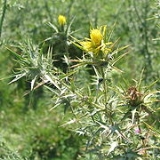
Carthamus lanatus
Encyclopedia
Carthamus lanatus is a species of thistle
known as woolly distaff thistle or saffron thistle. It is closely related to safflower
, which is in the same genus. This annual plant is a native of the Mediterranean Basin
, but it is familiar in other places where it was introduced
and has become a noxious weed, such as in parts of North America and southern Australia with similar climates. This is a spiny, glandular, woolly plant, which often looks like it is covered in spiderweb due to its fine tangled fibers. It has a pale stem which may reach a meter in height, and rigid, pointed, very spiny leaves. The flower head
has many long, sharp phyllaries
that can be up to several centimeters long, and often bend backwards (recurved). The disc florets are bright yellow. One plant can produce many stems which mat together due to their spininess and form a small thicket. The fruit is an achene
about half a centimeter long with many rigid pappus
scales.
In pastures, good pasture cover in Autumn will reduce germination, suggesting that pastures should be managed to reduce grazing pressure over summer increase the cover from summer-growing perennial grasses. Population models suggest that strategic grazing may be one of the most effective long-term control option for infested pastures.
Thistle
Thistle is the common name of a group of flowering plants characterised by leaves with sharp prickles on the margins, mostly in the family Asteraceae. Prickles often occur all over the plant – on surfaces such as those of the stem and flat parts of leaves. These are an adaptation that protects the...
known as woolly distaff thistle or saffron thistle. It is closely related to safflower
Safflower
Safflower is a highly branched, herbaceous, thistle-like annual. It is commercially cultivated for vegetable oil extracted from the seeds. Plants are 30 to 150 cm tall with globular flower heads having yellow, orange or red flowers. Each branch will usually have from one to five flower heads...
, which is in the same genus. This annual plant is a native of the Mediterranean Basin
Mediterranean Basin
In biogeography, the Mediterranean Basin refers to the lands around the Mediterranean Sea that have a Mediterranean climate, with mild, rainy winters and hot, dry summers, which supports characteristic Mediterranean forests, woodlands, and scrub vegetation...
, but it is familiar in other places where it was introduced
Introduced species
An introduced species — or neozoon, alien, exotic, non-indigenous, or non-native species, or simply an introduction, is a species living outside its indigenous or native distributional range, and has arrived in an ecosystem or plant community by human activity, either deliberate or accidental...
and has become a noxious weed, such as in parts of North America and southern Australia with similar climates. This is a spiny, glandular, woolly plant, which often looks like it is covered in spiderweb due to its fine tangled fibers. It has a pale stem which may reach a meter in height, and rigid, pointed, very spiny leaves. The flower head
Head (botany)
The capitulum is considered the most derived form of inflorescence. Flower heads found outside Asteraceae show lesser degrees of specialization....
has many long, sharp phyllaries
Bract
In botany, a bract is a modified or specialized leaf, especially one associated with a reproductive structure such as a flower, inflorescence axis, or cone scale. Bracts are often different from foliage leaves. They may be smaller, larger, or of a different color, shape, or texture...
that can be up to several centimeters long, and often bend backwards (recurved). The disc florets are bright yellow. One plant can produce many stems which mat together due to their spininess and form a small thicket. The fruit is an achene
Achene
An achene is a type of simple dry fruit produced by many species of flowering plants. Achenes are monocarpellate and indehiscent...
about half a centimeter long with many rigid pappus
Pappus (flower structure)
The pappus is the modified calyx, the part of an individual disk, ray or ligule floret surrounding the base of the corolla, in flower heads of the plant family Asteraceae. The pappus may be composed of bristles , awns, scales, or may be absent. In some species, the pappus is too small to see...
scales.
Detrimental
In Australia the plant is commonly regarded as a pasture weed because: it competes with desired plants such as pasture or crops, seeds and bracts become embedded in wool which results in lower returns to farmers, and because dense infestations restrict stock access and are difficult to walk through. Interestingly it is generally not considered a weed in much of Europe.Population biology
Seed germination is stimulated by red light. This means that germination is most likely in areas with little vegetation or pasture cover, e.g. when an area has been overgrazed. Seeds also require specific temperature cues and water, which means that most seeds germinate in Autumn (Fall). There are more C. lanatus seeds in the soil in Australian pastures than in similar French pastures, probably because there are more seed predators capable of removing seeds of this size in France than in Australia. Many C. lanatus seeds are dormant (will not germinate, even in ideal conditions), and seedbanks decrease by approximately 70-74% per year if no seed is added.Weed management
This plant can be controlled using a range of herbicides. Several biological control options have been investigated for Australia, including classical biological control, although finding an insect or fungus that will not also attach safflower has proven difficult. A rosette-feeding fly Botanophila turcica shows some promise. The potential for using pathogens already present in Australia has also been investigated.In pastures, good pasture cover in Autumn will reduce germination, suggesting that pastures should be managed to reduce grazing pressure over summer increase the cover from summer-growing perennial grasses. Population models suggest that strategic grazing may be one of the most effective long-term control option for infested pastures.

